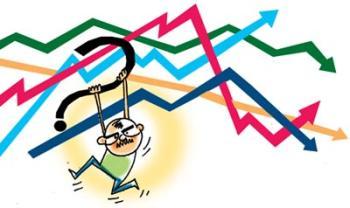
Anything in excess is harmful. Haven't we heard this umpteen times?
Be it drinking, smoking, partying, eating, or, coming to the point, investing. Yes! Over diversification of investments is also not good. Never put all your eggs in one basket, so goes the cliche. But again that does not justify diversifying more than required that it becomes difficult to handle your portfolio.
However, despite the fact there are people who try to juggle too many things at the same time. One such investor is Amit Bhatt, 35, a young banker with an MNC, who has a portfolio of 35 stocks. Yes, that's not a typo; you read that right. Nevertheless, Amit's a hassled man today as it is difficult for him to juggle his portfolio and his high-stress job.
He landed in this situation because he bought all those stocks that his friends had invested in. What further added to his woes is the fact that he had invested only a small amount in each of these 35 stocks. Now, in order for him to see any profit he has to wait for a substantial increase in the price.
Yes over diversification is as hazardous as not diversifying at all and to put it straight diversifying your portfolio is an art. But before we tell you the dangers of over-diversification let us try to understand the need to diversify?
Click NEXT to read about different types of risks to your portfolio.
The author is a certified financial planner and can be reached at dhanplanner@rediffmail.com.

The biggest argument behind diversification is risk.
Risk
Risk means a possibility of incurring loss or misfortune from your investments. Risk can be further divided into two sub-classes:
Systematic risk
Risk inherent to the entire market, is, in other words, un-diversified risk. Recession, war, interest rate risk all affect the overall market and hence no form of diversification can mitigate this risk.
Unsystematic risk
A company specific risk or industry-related risk, that is inherent to each and every investment. Also known as specific risk or diversifiable risk. For example, a workers' strike in a particular company can affect its business and this risk is company-specific and hence with adequate diversification this risk can be reduced.
Unsystematic risk is the risk for which an individual is advised to diversify his portfolio. But diversification of your investment should depend on the financial goals you need to achieve and the timeframe within which you need to achieve it. Most often individuals tend to invest in all asset classes they can think of. But is it good? No. Over-diversification can be dangerous.
Click NEXT to read why over-diversification is dangerous.

Too many stocks in your equity portfolio or too many mutual funds or too many assets (gold, silver, oil, stocks, fixed deposits, mutual funds etc) in your overall portfolio can make it difficult for you to track them. Today, given our fast-track life, we have little time for ourselves, and to keep track of one's portfolio is a huge task.
Again it is imperative to review your entire portfolio at least once in three months.
With too many shares or mutual funds or fixed deposits or in general too many assets in the portfolio, you start losing track. Many times your fixed deposit matures and you have no clue about it. In many cases your investments might be making losses, and with difficulty in tracking them, you don't realise it affecting your bottom line. This defeats the whole purpose of diversification.
2. Impact on returns
Over-diversification can happen especially when individuals blindly follow investment tips. Just like Sonal Gadecha, 26-year-old software professional, who invested in every stock tip that she got. Now to invest in a variety of stocks, she would buy not more than one to three shares of a company. Her investment is so small that to see any profitability, she has to wait for the prices to multiply at least 100 times!
As the investments are so small, even if she had some excellent investments, there is only marginal impact on returns.
Due to fact that she has invested only small amounts in a variety of stocks not only the returns get impacted but she misses out on good investment opportunities too. It is advisable to focus on 10 companies from diverse sectors and do bulk buying. So even a minimal increase in prices will show profits.
3. Cost
Individuals do not realise that by investing in 50 companies or 20 different mutual funds, they incur overhead costs such as brokerage fees, management fees and other transaction costs, not to forget the opportunity cost. These costs may be minimal but at the end of the day, they are deduced from your investments.
There is all the likelihood that they might even exceed your profits.
4. Paper work
Along with cost, there is also additional paperwork involved here.
Note: No matter how diversified your portfolio, your risk can never be reduced to zero. So making calculated and well researched investment decisions is very important.
Click NEXT to read how many stocks or mutual funds are good for your portfolio.

Over-diversification is a mistake which most of the individuals commit when it comes to stocks and mutual funds. Remember that beyond a certain number of stocks, further diversification is not going to reduce your risks.
So your obvious question would be how many stocks or funds are good in a portfolio? Here's an effort to figure that out.
Shares
Research shows that 15 to 20 stocks in your portfolio are good enough to diversify your risk. It is not that if you invested in 10 your risk is not reduced. The important thing is your investment has to be well informed. The stocks selected should be adequately researched and from diverse sectors and not concentrated to any one particular sector.
Mutual funds
The very crux of investing in mutual funds is that your investments get spread over a large number of assets.
In other words, your investments are diversified. If you start investing in every second fund that comes your way or all new fund offers then the whole purpose of diversifying is defeated. An ideal of 6 funds of a particular category, that is, say you are investing in equity diversified funds, then anything more than 6 funds of this category in your portfolio becomes very difficult to track.
Similarly remember that if you have more than one fund of a particular fund house then try to consolidate them under one folio number so that it is easy to track them and you have less number of folios to manage.
Bottom line: Stay focused, invest wisely, and enjoy the fruits of your investments.